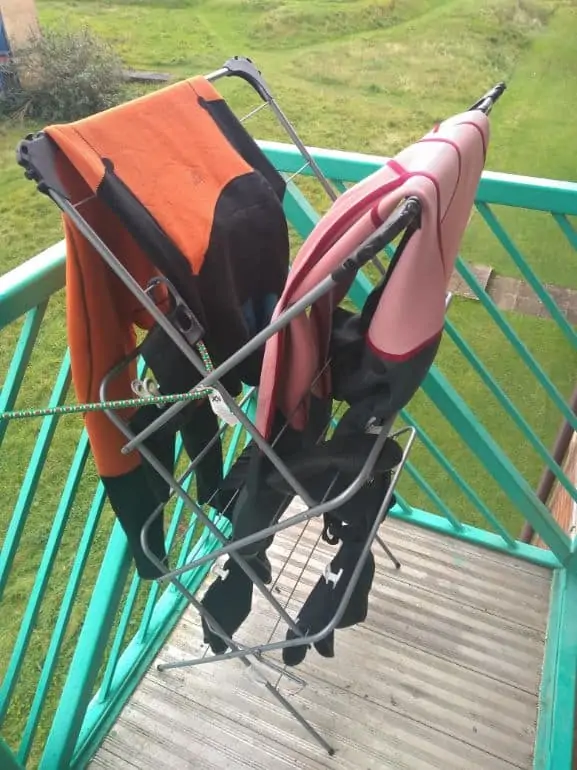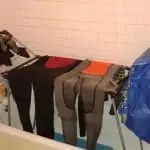HERE’S How You Dry a Wetsuit! (Everything You Can Do)
After using your wetsuit, you will have the unavoidable task of getting it dry before the next time you want to use it.
For a piece of kit that is so easy to use, actually getting it to dry can be quite tricky as there are quite a few pitfalls that you’ll need to avoid if you want to get the most use out of your wetsuit and the best quality from it.
So, how do you dry a wetsuit? Hang it up, folded at the waistline inside out in indirect sunlight or in a warm, ventilated place. Leave your wetsuit to drip dry for 6 to 12 hours, depending on how warm it is and turn it inside out at the halfway point and leave it to dry again.
Leaving it to drip dry is the only way to get your wetsuit to dry, there are no real ‘hacks’ you can use to speed this up, although I’ll cover every possible option below.
Now let’s go through more of the specifics on this in detail below.
UPDATE: Since writing this post, the C-Monsta wetsuit, boot and glove hanger has come out and it’s brilliant, I have to say. Hats off to Mark, who designed it – it’s a great bit of kit and now my recommended wetsuit hanger. I bought one for myself, my wife and my brother and we all use it all the time.
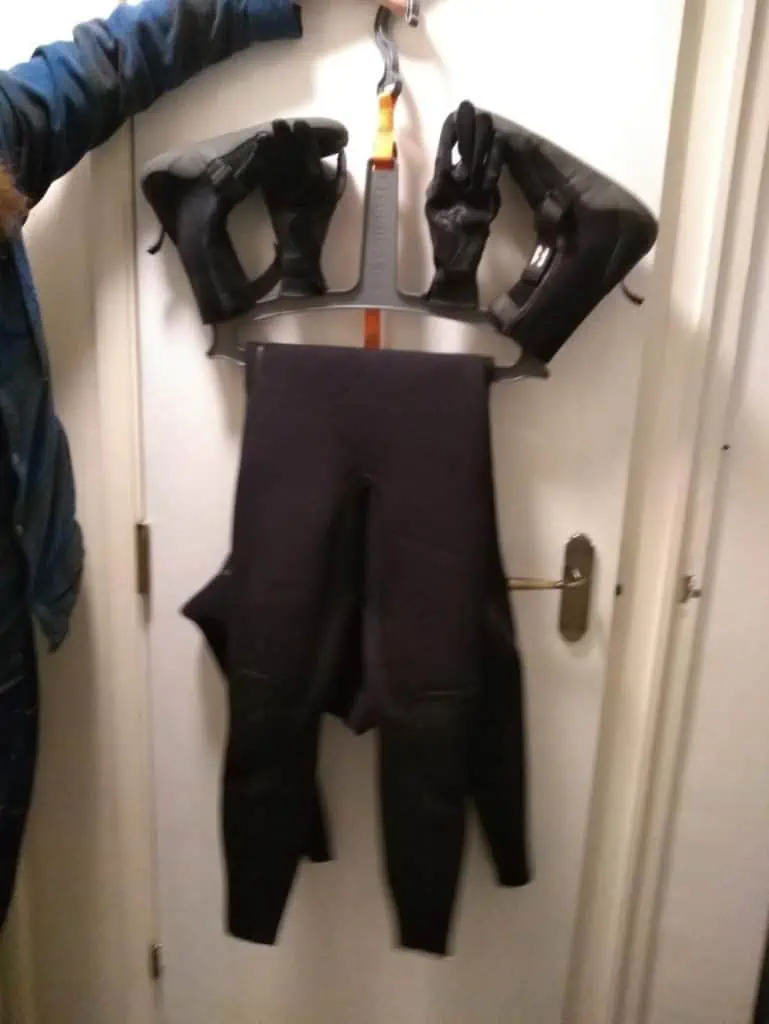
How long does it take to dry a wetsuit?
6 hours in the warmest climates for a thinner summer wetsuit, 3/2mm in thickness, and then up to 24 hours for a 4/3 or 5/4mm winter wetsuit in cooler climates. This is because you have to leave them to drip dry and the ambient temperature affects the rate of drying very much so.
So colder climates takes longer, whereas in warmer climates, you can get it done quicker and you’ve got a thinner wetsuit.
Where can I dry my wetsuit?
Outdoors in the shade is perfect for drying wetsuits, hung up on some kind of laundry rack. I’ve got more on this in a dedicated article here, so check that out.
In bad weather, my wife and I put our wetsuits in the bath on a laundry rack, again explained in my other article on this, or you can put your wetsuit on some kind of rack in your house with a Tubtrug (Amazon) or similar bucket below it to catch the drips so you don’t need to worry about it causing salt stains on your carpet or ruining your floors with dripping items.
Remember do not dry your wetsuit in direct sunlight because the UV rays from the sun are too intense for the wetsuit, and it will degrade the quality of it quite quickly, meaning that your wetsuit will not last as long as it should and that it will start to break down.
This is because the UV rays can damage the neoprene and this breaking down means things like the seams will come looser. Parts of your wetsuit will let in more water than it should making it colder and not function as a proper wetsuit.
You will also see the manufacturer’s warranty guarantee stamped on your wetsuit somewhere saying, “Do not leave in direct sunlight.” And if you do, you cannot claim anything back on that first year of your warranty because the manufacturers recognise this and they say not to do it for good reason.
If you need to dry your wetsuit at the beach, get a portable, wetsuit drying rack (Amazon) to hang on your car. This rack keeps your wetsuit off the paintwork of your car, preventing issues from corrosion as happens over time if drying your wetsuit directly on a wing mirror regularly.
Not least because your car is worth a lot more than your wetsuit (or at least for the vast majority of people!!).
The portable drying rack simply gives a bit of separation between wetsuit and car, meaning you can still dry your wetsuit at the beach on the wing mirror, but it takes the wetsuit off the surface of the car so you don’t have to worry about that salt water corroding things.
Can you spin dry a wetsuit?
No, you cannot because the spinning cycle is too intense for a wet wetsuit or any wetsuit, and it will come apart at the seams quite quickly. This will also void the warranty, so you will have no comeback if you destroy your wetsuit doing this.
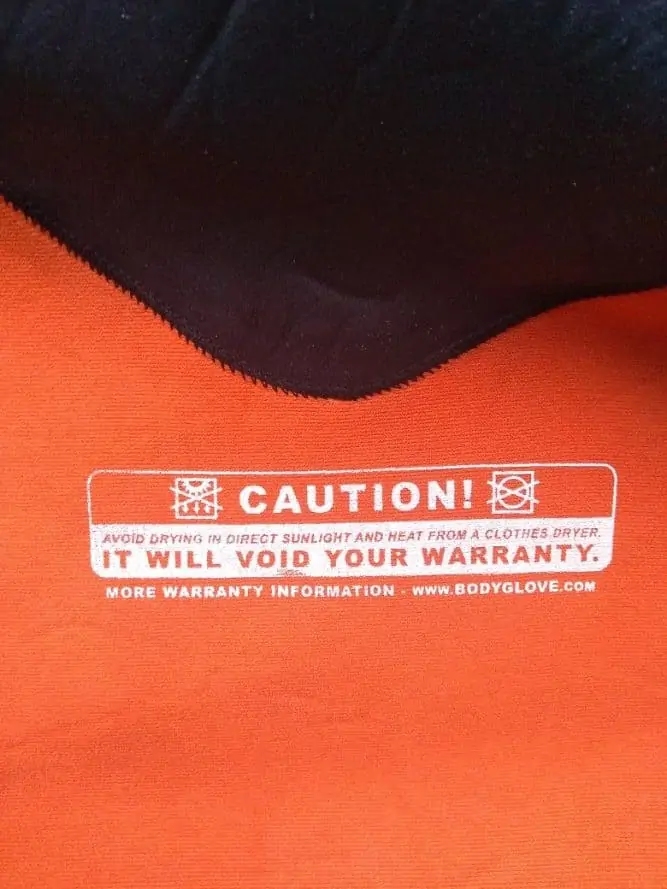
The heat of spin drying or tumble drying will also start to melt some of the neoprene and degrade the quality of it, again making it let in more water, feel colder for you, and vastly shorten the life.
And by this, it could be as short as a few months if you spin dry it several times. Instead, always remember to hang your wetsuit out on an appropriate rack, and don’t be tempted to rush through it.
To avoid having to get into a wet wetsuit all of the time, you have two options:
- One, buy a backup wetsuit so always have a dry one and have them on rotation. This is really nice if you have the money, but obviously things can get very expensive very quickly with that. But it’s certainly a good way to go.
- Or buy under layers like rash guards and shorts and so on to help you when you’re putting on the wet wetsuit, at least that then means you have less wet neoprene or wetsuit to get into, reducing the shock of it and making it that much more pleasant. This is the cheaper option, but it is not quite as good as having a nice dry wetsuit as an alternative at all times. But those are your main two options for avoiding having to get into a wet wetsuit.
Wetsuit drying rack.
As I’ve touched on earlier in this post, a wetsuit drying rack can be fashioned out of a laundry rack, which is what I do and is the best thing I have found. I put my suit on a rack over the bath overnight.
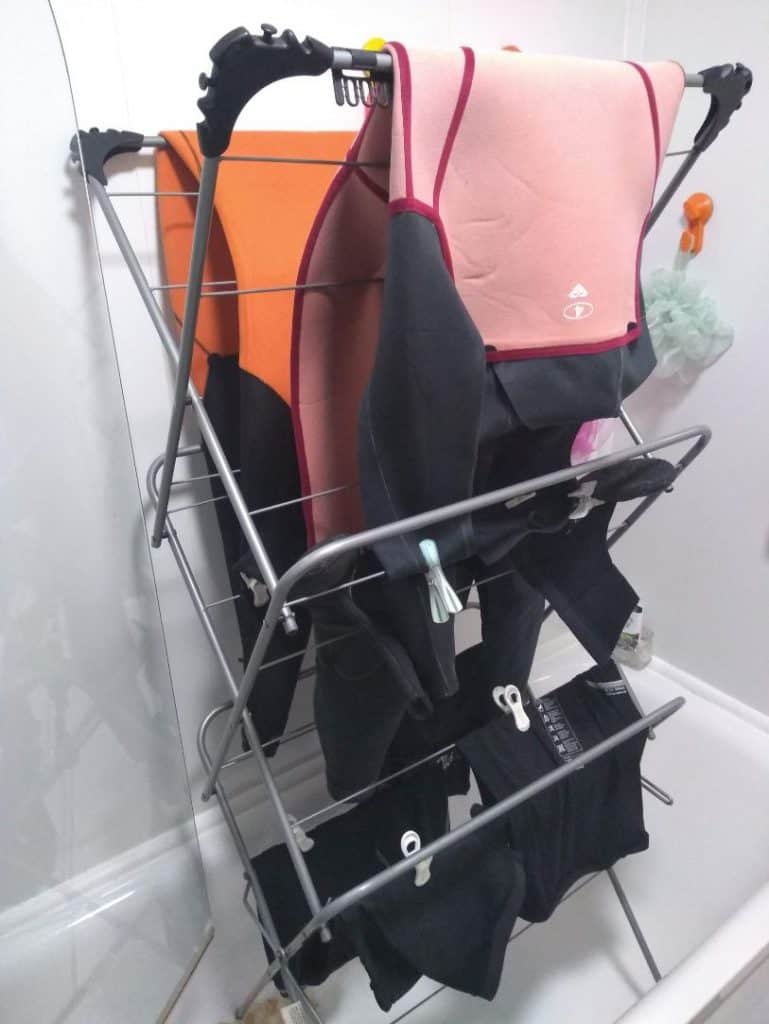
That works well because then it catches the drips and I don’t need to worry about it being left out in the rain or getting wet from the rain.
It’s also a folding rack, so I don’t have to worry about it taking up a huge amount of space in my tiny apartment, which is always appreciated. And my wife likes it too. In fact, it was her idea, so I should give her the credit there!
If you don’t have space for drying rack or laundry rack, then just look for some kind of bar or pole that you can hang your wetsuit across where it can drip down either outdoors or indoors and where the drips won’t be a problem, or at least where you can put a bucket underneath it.
How to clean a wetsuit?
The best way to clean your wetsuit is to:
- Rinse it thoroughly in fresh water, after a surf in a bucket to catch the sand before it goes down your drain.
- Add some baby shampoo or some very light detergent into the bucket, and that will then help to clean your wetsuit and get rid of the nasty smell that it can have after many uses.
- For new wetsuits, to avoid doing anything to risk losing the warranty, you can buy a special wetsuit shampoo online from places like Amazon that will guarantee a cleaner wetsuit and also not hurt your chances of claiming anything on the warranty within that period.
- After cleaning your wetsuit, make sure you leave it to drip dry as normal to allow that cleaning process to come full circle before you use it again.
- Clean your wetsuit with a light shampoo once every three months or so if you use it often to help keep the smells at bay and also for peace of mind.
How do you store a wetsuit when not in use?
Put your wetsuit in any kind of container, fold it lightly, not too tightly, and roll it into a small space, and then put it in a bag or a box and it’s fine, as long as it is completely dry. Store it out of direct sunlight to make the wetsuit last longer.
If it is not dry, then it can start to really smell very badly very quickly. So dry your wetsuit, then lightly roll or fold it into the suitable container.
How do you dry a wetsuit overnight?
This is only possible in warm temperatures with thinner 3/2 millimetre summer wetsuits or less, where wetsuits are left to drip dry for 4-6 hours. Otherwise, for colder temperatures and thicker wetsuits, this is not possible without damaging the wetsuit.
The last point is because thicker, cold-water wetsuits retain so much more water and they have much more material to dry.
To speed up the drying process, you can try putting a wetsuit in an airing cupboard or having some kind of fan on it to blow off the water, but this is still no guarantee if the ambient temperature is cool.
How long does a wet to take to dry?
6 hours for 3/2mm thick wetsuits in summer temperatures and 24 hours for cold-weather climates with winter wetsuits or 4/3mm or 5/4mm in thickness. The warmer, thinner and shorter the wetsuit, the quicker it dries.
There is no way around this time without damaging the wetsuit in the long term.
How long does a wetsuit last?
A 3/2mm thick wetsuit lasts three to four years of heavy use, but longer if used less frequently and taken care of. Thicker 4/3 mm or 5/4 mm wetsuits last two years of heavy use or maybe three to four with light use.
This is because the quality of the wetsuit degrades over time, the seams become loose with regular use and movement, etc. and the suit gradually starts to let in more water.
This is not such a problem for summer wetsuits, but it is a major problem for cold water surfers with winter wetsuits. So expect to buy a new wetsuit every three years for a summer if you’re a heavy user or regular surfer, or every two years if you’re surfing in colder temperatures.
How do you dry wetsuit indoors?
Hang it up to drip dry in a well ventilated and warm room of your house. If you can, in the airing cupboard, as long as this does not affect moisture. Turn the wetsuit inside out after a few hours of drying, and leave it to drip dry on the other side, as it will not get the inside or the reverse dry if you do not do this.
How do you dry a wetsuit in a car?
Place a cord between the handles on the inside of your car and hang your wetsuit over that at the waistline. Put a bucket underneath it, and it will start to dry. However, be careful not to get direct UV rays or sunlight on your wetsuit, as this will damage it.
Drying your wetsuit inside your car will also make for a very unpleasant smell on your upholstery, which could be hard to remove. A better option would be to get a portable wetsuit drying rack to hang on your wing mirror and do it on the outside of your car if you can, as this will drip dry naturally outdoors.

The Malo’o Portable Wetsuit Drying Rack, on Amazon
Although your wetsuit still will be in direct UV sunlight, it will be better than drying it in your car. It might take longer, but it will not risk any damage to your car at all, as drying inside might.
Related questions
How to dry a wetsuit quickly? Increase the temperature of the room and put a fan on your wetsuit, but do not put it in direct UV light or sunlight. Airflow and ambient temperature are the only two safe ways to speed up the drying process of your wetsuit.
Otherwise, if you dry it quickly by leaving it in the sun, your wetsuit will not last as long and it will void the warranty, so really be careful with that.
Can you tumble dry wetsuits? They do fit in a tumble dryer, but tumble drying your wetsuit will destroy it very quickly and void the warranty. It will only last a few months at maximum if you do this, and you will have uncomfortable, cold, and useless surfs in it if you do.
The wetsuit manufacturer’s warranty says not to do this and spin-drying in a tumble dryer will melt the neoprene and degrade the quality of it, letting in a lot more water.
It will also make it come apart at the seams and just not function as it. I have done this in my own experience when I was a naive teenager and I really regretted it. So take my advice. I learned the hard way so you don’t have to!
